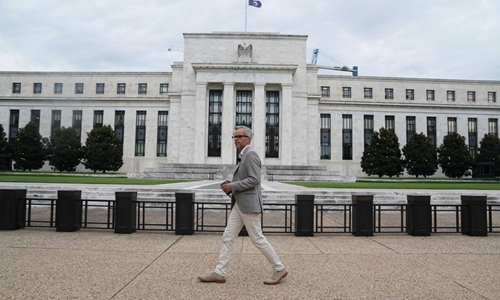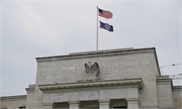
A man walks by the US Federal Reserve building in Washington D.C., the United States, on July 31, 2019. (Xinhua/Liu Jie)
An unprecedented quantitative easing package rolled out by the US Federal Reserve to save a slumping economy may ameliorate fears in the global markets for the moment, economists said, but the US central bank's historical show of force could set the stage for even greater risks.
Going all-in, the Fed announced Monday an unlimited QE plan and several new lending programs, amid mounting fears that the US economy is on pace to post an unprecedented contraction in the second quarter.
Earlier in March, the Fed made two emergency rate cuts that slashed its target fed funds rate to virtually zero, and it also launched a $700 billion QE program.
The US dollar's strength has continued lately, although the US economy appears to be in bad shape, sending shockwaves through global markets, according to Bank of Communications' chief economist Lian Ping.
The latest move would be propitious for global markets in the short run, Lian told the Global Times on Tuesday.
With the new, unlimited bond-buying program that enables more corporate bonds and exchange-traded funds purchases, the Fed moves closer to the correct approach to ease market volatility, Lu Zhengwei, chief economist at Industrial Bank, told the Global Times.
Asian-Pacific equity markets posted a strong rebound on Tuesday, with the Korea Composite Stock Price Index, South Korea's benchmark, closing up 8.6 percent to record its biggest rise since November 2008, and Japan's Nikkei index soaring 7.13 percent in its biggest rally since mid-February 2016. Australia's ASX200 index rose 4.17 percent.
Chinese mainland shares ended higher, consolidating gains despite wild swings during the day. Hong Kong's Hang Seng Index recovered its losses in the previous session with a 4.46 percent rally on Tuesday.
In a most encouraging sign, continued net outflows from the Chinese mainland market via the northbound trading links tying Hong Kong and mainland bourses reversed into net inflows on Tuesday.
Rising gold and crude oil prices plus signs of a broad-based rebound in European and US stocks Tuesday seem to have justified the effectiveness of the Fed's newest prescription in calming the markets.
Nonetheless, as Lian put it, the Fed's no-holds-barred stance may eventually have a ripple effect, and whether the market turmoil will pause depends on how effectively the coronavirus pandemic can be contained.
The effect of the Fed's policies would gradually be shown when the virus onslaught sees signs of plateauing, he commented, calling attention to the worrying side effects of the Fed's moves.
While market views differ on whether a new global financial crisis is in the making following the one set off by the collapse of Lehman Brothers in 2008, anxiety is on the rise over the side effects of the excessive use of monetary tools at a time when the turning point of the pandemic outside of China is not in sight.
The Fed's two extraordinary rate cuts earlier this month shocked the markets, indicating that imprudent policy itself turns out to be a source of turbulence. In light of this, the Fed's third hyper-conventional action is essentially about resorting to monetary policy singlehandedly, which might prove to be going too far, ICBC International economists Cheng Shi and Qian Zhijun said in a research note sent to the Global Times on Tuesday.
The Fed's QE approach to the 2008 financial crisis, albeit being wound back over the past 10 years, underpinned a bull run in US stocks, Lian said.
The latest market rout has wiped out roughly $24 trillion from the US stock market, a wake-up call that the Fed's unprecedented moves would only be brewing greater risks in years to come, the economist said.
"Judging by Lehman's bankruptcy, which led to the collapse of a host of financial institutions and the resulting rapid drying up of liquidity, we're still not there," he said, speaking of the next global financial crisis.


